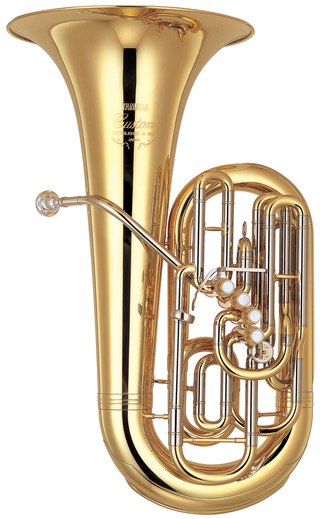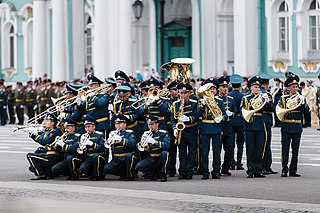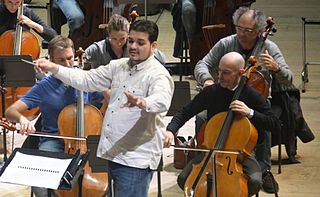
A brass instrument is a musical instrument that produces sound by sympathetic vibration of air in a tubular resonator in sympathy with the vibration of the player's lips. The term labrosone, from Latin elements meaning "lip" and "sound", is also used for the group, since instruments employing this "lip reed" method of sound production can be made from other materials like wood or animal horn, particularly early or traditional instruments such as the cornett, alphorn or shofar.

The euphonium is a medium-sized, 3- or 4-valve, often compensating, conical-bore, tenor-voiced brass instrument that derives its name from the Ancient Greek word εὔφωνος euphōnos, meaning "well-sounding" or "sweet-voiced". The euphonium is a valved instrument. Nearly all current models have piston valves, though some models with rotary valves do exist.

The flugelhorn, also spelled fluegelhorn, flugel horn, or flügelhorn, is a brass instrument that resembles the trumpet and cornet, but has a wider, more conical bore. Like trumpets and cornets, most flugelhorns are pitched in B♭, though some are in C. It is a type of valved bugle, developed in Germany in the early 19th century from a traditional English valveless bugle. The first version of a valved bugle was sold by Heinrich Stölzel in Berlin in 1828. The valved bugle provided Adolphe Sax with the inspiration for his B♭ soprano (contralto) saxhorns, on which the modern-day flugelhorn is modelled.

A musical ensemble, also known as a music group, musical group, or a band is a group of people who perform instrumental and/or vocal music, with the ensemble typically known by a distinct name. Some music ensembles consist solely of instrumentalists, such as the jazz quartet or the orchestra. Other music ensembles consist solely of singers, such as choirs and doo-wop groups. In both popular music and classical music, there are ensembles in which both instrumentalists and singers perform, such as the rock band or the Baroque chamber group for basso continuo and one or more singers. In classical music, trios or quartets either blend the sounds of musical instrument families or group instruments from the same instrument family, such as string ensembles or wind ensembles. Some ensembles blend the sounds of a variety of instrument families, such as the orchestra, which uses a string section, brass instruments, woodwinds, and percussion instruments, or the concert band, which uses brass, woodwinds, and percussion. In jazz ensembles or combos, the instruments typically include wind instruments, one or two chordal "comping" instruments, a bass instrument, and a drummer or percussionist. Jazz ensembles may be solely instrumental, or they may consist of a group of instruments accompanying one or more singers. In rock and pop ensembles, usually called rock bands or pop bands, there are usually guitars and keyboards, one or more singers, and a rhythm section made up of a bass guitar and drum kit.

The trombone is a musical instrument in the brass family. As with all brass instruments, sound is produced when the player's vibrating lips cause the air column inside the instrument to vibrate. Nearly all trombones use a telescoping slide mechanism to alter the pitch instead of the valves used by other brass instruments. The valve trombone is an exception, using three valves similar to those on a trumpet, and the superbone has valves and a slide.

The tuba is the largest and lowest-pitched musical instrument in the brass family. As with all brass instruments, the sound is produced by lip vibration – a buzz – into a mouthpiece. It first appeared in the mid-19th century, making it one of the newer instruments in the modern orchestra and concert band, and largely replaced the ophicleide. Tuba is Latin for "trumpet".

The bass trumpet is a type of low trumpet which was first developed during the 1820s in Germany. It is usually pitched in 8' C or 9' B♭ today, but is sometimes built in E♭ and is treated as a transposing instrument sounding either an octave, a sixth or a ninth lower than written, depending on the pitch of the instrument. Having valves and the same tubing length, the bass trumpet is quite similar to the valve trombone, although the bass trumpet has a harder, more metallic tone. Certain modern manufacturers that sell 'valve trombones' and 'bass trumpets' employ the same tubing, valves, and bell in different combinations; in these circumstances, the bass trumpet is nearly similar to the valve trombone.

The valve trombone is a brass instrument in the trombone family that has a set of valves to vary the pitch instead of a slide. Although it has been built in sizes from alto to contrabass, it is the tenor valve trombone pitched in B♭ an octave lower than the trumpet which has seen the most widespread use. The most common models have three piston valves. They are found in jazz and popular music, as well as marching bands in Europe, where they are often built with rotary valves and were widely used in orchestras in the 19th century.

A brass quintet is a five-piece musical ensemble composed of brass instruments. The instrumentation for a brass quintet typically includes two trumpets or cornets, one French horn, one trombone or euphonium/baritone horn, and one tuba or bass trombone.The two instrumentations of the brass quintet that are currently in use are the quintet of two trumpets, horn, trombone, and tuba; and the quintet of two trumpets, horn, trombone, and bass trombone"(Lindhaul 1988). Musicians in a brass quintet may often play multiple instruments. Trumpet players for instance may double on piccolo trumpets and flugelhorns. There can be variation in instrumentation depending on the type of quintet. In some quintets, the horn is replaced by an additional trombone. Euphonium may also be substituted for the trombone part. While the tuba is considered a standard, the range and style of many pieces lend themselves to being played with bass trombone as the lowest-pitched instrument. Additionally, some pieces call for the use of percussion instruments, particularly the snare drum, tambourine, or timpani.

The cimbasso is a low brass instrument that covers the same range as a tuba or contrabass trombone. First appearing in Italy in the early 19th century as an upright serpent, the term cimbasso came to denote several instruments that could play the lowest brass part in 19th century Italian opera orchestras. The modern cimbasso design, first appearing as the trombone basso Verdi in the 1880s, has four to six rotary valves, a forward-facing bell, and a predominantly cylindrical bore. These features lend its sound to the bass of the trombone family rather than the tuba, and its valves allow for more agility than a contrabass trombone. Like the modern contrabass trombone, it is most often pitched in F, although models are occasionally made in E♭ and low C or B♭.
Václav Nelhýbel was a Czech-American composer, mainly of works for student performers.
Banda is a subgenre of regional Mexican music and type of ensemble in which wind and percussion instruments are performed.

Frigyes Hidas was a Hungarian composer.

The brass section of the orchestra, concert band, and jazz ensemble consist of brass instruments, and is one of the main sections in all three ensembles. The British-style brass band contains only brass and percussion instruments.

The trumpet repertoire consists of solo literature and orchestral or, more commonly, band parts written for the trumpet. Tracings its origins to 1500 BC, the trumpet is a musical instrument with the highest register in the brass family.
Dixieland jazz, also referred to as traditional jazz, hot jazz, or simply Dixieland, is a style of jazz based on the music that developed in New Orleans at the start of the 20th century. The 1917 recordings by the Original Dixieland Jass Band fostered awareness of this new style of music.

Georgi Kornazov is a Bulgarian jazz trombonist and composer, who lives in Paris, France.

Giancarlo Castro D'Addona is a Venezuelan – Italian composer, conductor and trumpet player. Gold medal winner at the Global Music Awards in San Diego – California (US).
Igor Krivokapič is a Slovenian composer, retired tubist and instrument inventor.

The soprano trombone is the soprano instrument in the trombone family of brass instruments, pitched in B♭ an octave above the tenor trombone. As the bore, bell and mouthpiece are similar to the B♭ trumpet, it tends to be played by trumpet players rather than trombonists. Compared to tenor, bass, or even uncommon alto, the soprano is a rare trombone. Seldom used in classical music since its first known appearance in 1677, it survived principally in the trombone ensembles of Moravian Church music. During the 20th century some soprano trombones—dubbed slide cornets—were made as novelties or for use by jazz trumpet players including Louis Armstrong and Dizzy Gillespie. A small number of contemporary proponents of the instrument include jazz artists Wycliffe Gordon and Christian Scott, and classical trumpeter Torbjörn Hultmark, who advocates for its use as an instrument for young children to learn the trombone.

















